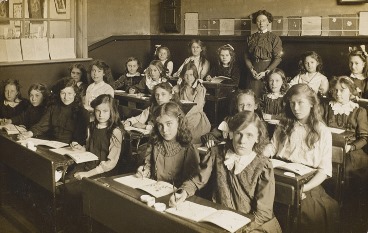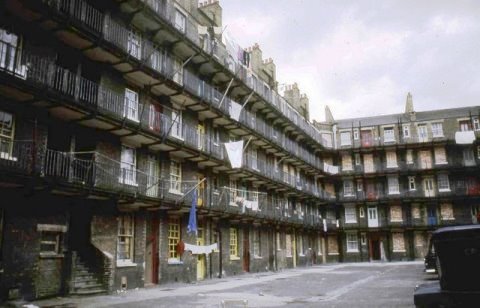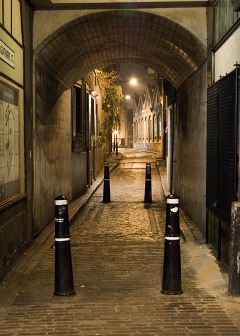martha mallindine + george crow
Martha’s birth record has not been found but subsequent records place her date of birth about 1846. She was the daughter of John Forecast and Martha Ann Mallindine but it appears their relationship ended shortly after Martha’s birth. Her mother had several subsequent relationships but it is not know what impact they played in Martha’s life or whether she ever saw her father.
In 1861, Martha was living with her mother and two brothers at 4 Well Street in Stepney but eighteen months later when she was just 17 years old, she admitted herself to the Stepney Workhouse. She was admitted at 7pm and the admission register listed her last address as 28 Preston Street which was the same address her brother gave when he married in 1865. Her occupation was listed as Needlework and under Cause of Admission, they entered ‘crippled’ which presumably meant she could not work to fully support herself. She stayed in the workhouse for 5 days but three weeks later, she was readmitted but this time her previous address was listed as her mother’s house at 4 Well Street so it appears she returned there after her first stay in the workhouse but for whatever reason was unable to stay with her family.
On 18 December 1866, Martha married George Crow at St James the Great in Bethnal Green with Frederick and Harriet Crow standing as witnesses. George was born in Whitechapel in 1847 to John Crow, a Baker, and his wife Jane Watson. George was working as a Cage Maker when they married but both his and Martha’s addresses were listed simply as Bethnal Green. Although Martha married under the name Mallandine, she listed her father as John Forecast, deceased.

Four months after their marriage, their first son, Alfred George, was born in Whitechapel on 8 April 1867 followed by Elizabeth Martha on 26 November 1870 — although her birth was not registered until the following year. In 1871, Martha and her two young children were living with her mother at Bakers Row in Whitechapel and working as a Fancy Box Maker but her husband George has not been found elsewhere in the census. Martha Louise was baptised on 5 February 1874 at St Bartholomew in Bethnal Green along with their two older children, Alfred and Martha.
The family was living at 6 Eastman Street and were still there when son George Edward was born on 24 May 1876; he was baptised on 5 July at St James the Great. In September, Alfred was enrolled in the Wilmott Street School after a period of 9 months out of school and even though he was almost ten, he had only spent two years in school but he still fared better than another student who was described in the school register as ‘utterly ignorant’.
In 1878, Alfred, Elizabeth and Martha were admitted to the Stepney Workhouse from the Forest Gate District School in neighbouring Essex. The school was a joint venture of the Boards of Guardians of the Hackney, Poplar and Whitechapel Unions to educate pauper children and in most cases, children who were admitted to the workhouse unaccompanied by a parent were sent to these residential type schools. George and Martha may have been unable to support their children with the workhouse the only option or it is possible they were admitted as a means of gaining an education. On 13 June 1878, they were transferred from Forest Gate to the Stepney Workhouse and discharged two days later, presumably to their parents although there is no notation in the discharge book to confirm this.
Edward John Mallandine was born on 18 November 1879 and the following year, Elizabeth moved to the Berner Street School when the family left Eastman Street and settled in Ellen Street and her little brother George was enrolled in school for the first time. When the 1881 Census was taken, Martha and George were living with their five children at 3 Ellen Street in the parish of St George in the East in Stepney and the family was reliant on George’s wages from his work as a Cage Maker.
Alfred and Elizabeth appear to have remained with their parents but their daughter Martha was readmitted to the Forest Gate School through the workhouse and the register describes her as having a ‘weak mind’ which probably referred to a development disability. But it seems she still spent time with her family as she was admitted to the Stepney Workhouse on 12 November 1883 and taken to her mother’s the same day. Another workhouse admission entry on 1 July 1884, notes that her family was living in 35 New Buildings in George Yard and in the final entry on 26 July 1885, she was described as an ‘imbecile’ and from there she was transferred to the Colney Hatch Lunatic Asylum in the London borough of Barnet. There is no further record of Martha and she is presumed to have remained in the asylum until her death.
On Sunday 12 August 1888, the Lloyd’s Weekly London newspaper reported on the murder of a young woman in the George Yard Buildings off the Whitechapel Road in the early hours of the morning on the previous Tuesday. An inquest was held at the Working Lad’s Institute in Whitechapel where the woman was identified as Martha Tabram also known as Turner, a 38 year old woman who lived in Star Place off Commercial Road. She was discovered at 5am by John Saunders Reeves, a Waterside Labourer who lived at number 37, when he left home to try and find work for the day. He saw her lying on her back in a pool of blood on the first floor landing and immediately raised the alarm with the local constables.
Another witness called at the inquest was Alfred George Crow who lived at 35 George Yard; he testified that he returned home from work as a Cabman about half past three in the morning and on his way up the stairs, he noticed someone lying on the landing but since it was a common occurrence, he took no notice and carried on his way and went to bed. As there was no light in the staircase, he told the coroner that he did not notice if the person was alive or dead. Elizabeth Mahoney, another resident in the building, stated that when she returned home with her husband at 2am, the landing was clear so the coroner concluded that Martha Tabram must have been murdered between 2 and 3:30 in the morning on 7 August.
The doctor who attended the scene and later performed the post-mortem testified that he found 39 stab wounds to Martha’s neck, breast and abdomen with some wounds caused by a long, strong instrument such as a bayonet or dagger and the others by a pen knife. Inspector Edmund Reid of the Metropolitan Police was put in charge of the investigation and even though a number of possible suspects were interviewed, the murderer was never identified. Several weeks later, the first of the five Whitechapel murder victims, Mary Ann Nichols, was found in nearby Buck’s Row and contemporary newspaper accounts soon linked Martha Tabrams’ murder with that of Mary Ann and Annie Chapman who was killed in the first week of September. As the number of victims grew, the murders were linked to the notorious serial killer Jack the Ripper but as the nature of Martha’s injuries and the circumstances of her death differed from subsequent victims, there was a dispute between those who believed a link to the Ripper existed and those who refuted it.
In 1891, the Crow family was living in the Lolesworth Buildings on Thrawl Street, just off Commercial Street near Christ Church in Spitalfields. The tenement was built in 1885 by the East End Dwellings Company — which was formed by a group of parish workers from the nearby church of St Jude’s in Whitechapel — whose aim was to build housing, let by the room, that even the poorest class of workers could afford. There was an increasing demand for housing in the East End due to both population growth and the ongoing immigration of Jews escaping the pogroms in eastern Europe and although the Lolesworth Buildings were designed to house 380 people, shortly after its completion in 1887, the tenement was already overcrowded with families as large as ten occupying just one single room. In 1886, the Metropolitan Board of Trade approved plans to erect another tenement across the street by the Four Per Cent Industrial Dwellings Company which was founded in 1885 by Lord Rothschild to provide housing to poor Jewish workers in the East End — this tenement was known as the Charlotte De Rothschild Dwellings.
Like many other families in the Lolesworth Buildings, the Crows at number 26 occupied just one room. Three of their five children were still living with them: Alfred was working as Groom and Cab Driver, George as an errand boy and Edward was in school. Their 20 year old daughter, Elizabeth Martha, was working as a Domestic Servant for James Carruthers, a draper in Kensington at 5 Roland Gardens.

© Derek Voller
On 8 August 1892, their son Alfred married Mary Ann Woodbridge at Christ Church in Spitalfields. Next to marry was George Edward to Jane Mary Gorbell at St Andrew in Bethnal Green 31 July 1898 and three years later, Elizabeth married Frederick James Edwards on 16 February at St Andrew and St Philip in Kensal Green; they had two daughters, Lizzie and Rosie Annie.
Martha and George were still living in the Lolesworth Buildings in 1901 but only their youngest son Edward remained at home. George was employed as a Wire Worker and worked at home on his own account, likely doing piece work while Edward worked as an Isinglass Cutter which referred to someone who prepared a type of gelatin obtained from fish, especially sturgeon, that was used to make jellies and glue and for clarifying ale. The census also noted that Martha suffered from a debility, specifically that she had ‘no use in legs’.
Two years later, Martha died and was buried in the Manor Park Cemetery on 9 November; the burial record lists the cause of death as myxoedema, which was a term for hypothyrodism, and one common symptom is swelling of the lower legs which could explain her debility listed in the 1901 census. George hasn’t been traced in the 1911 census and there is no information on what happened to him after Martha’s death but it appears he died in Poplar in 1917.
Their youngest son Edward married Florence Ruth Buckley at St Philip in Stepney on Christmas Day in 1904 and they went on to have three children: Florence Adelaide Maud, Alfred Frederick Buckley and John Edward. Their youngest son John died on 31 August 1918 aged only seven years. Florence died in Poplar in 1929 and ten years later, Edward was living at 63 Drake Road in Harrow with his daughter Florence and her family. Edward died in Berkshire in 1958 but he was buried on 1 October in the family plot in the Tower Hamlets Cemetery along with his wife and son John.
Alfred George moved his family to Cardiff by 1901 and he appears there along with his wife and four children: William, Mary Ann Elizabeth, Alfred George and Harry. But they had returned to the East End by 1911 and were living on Menotti Street in Bethnal Green where he worked as a Wire Worker like his father. There is a possible death record for Alfred in Shoreditch in 1925.
George Edward and his wife Jane remained in Bethnal Green for ten years after their marriage before moving south of the Thames to Delph Court near the Borough Market in Southwark. They had five children: George Alfred Samuel, Alfred William, Jane Elizabeth Martha, Mary Ann Alice and William Edward. But they too lost a son when George Alfred Samuel died aged 9 in 1909.
On 9 November 1914, George Edward enlisted in the army at Deptford and was assigned to the Army Service Corps as a Driver — likely because of his experience as a Carman. He is described on his attestation papers at 5’ 5’’ tall with ‘various tattoos on both forearms’ and he had shaved 6 years off of his actual age of 38. His military record notes that he was wounded on 19 April 1918 but there are on no further details on when, where or how this occurred. George died in Southwark in 1935 and his wife Jane in 1942.
